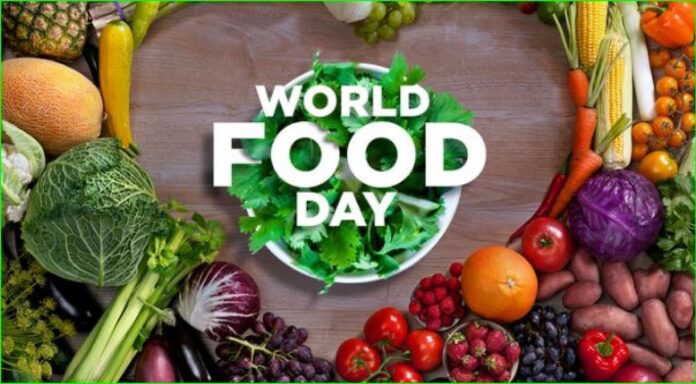Every year 16th October is celebrated as World Food Day across the globe in remembrance of the day when the Food and Agricultural Organisation (FAO) of the United Nations was founded in 1945. Officially, World Food Day was established by FAO’s Member Countries at the Organization’s 20th General Conference in November 1979.
This day is celebrated to promote global awareness and action for those who suffer from hunger, and to highlight the need to ensure healthy diets for all. The basic purpose of celebrating this day is to raise awareness for the people who don’t have the privilege of safe and proper food and die from hunger and starvation. Though the primary focus of World Food Day celebration is to tackle global hunger and to strive to eradicate hunger across the world, when we look at world hunger facts, we get confronted with very disappointing figures.
Different nations should end their conflicts and try to live in peace and harmony. World countries need to spend more on new food producing technologies than on arms and ammunition to enhance their food production and to raise the living standard of their people. Different world agencies should try to adopt and develop new strategies to eradicate the food disparity in different regions of the world
There are about 821 million people chronically undernourished, more than 785 million recorded in 2015 and nearly 99 percent of these undernourished people live in developing nations. About 60 percent of the hungry people in the world are women. About 50 percent of all deaths in children are under five years old due to under-nutrition. It has been observed that from 2019 to 2022, the number of undernourished people grew by as many as 150 million, a crisis driven largely by conflicts, climate change, and the covid-19 pandemic. As per the reports of Action Against Hunger, an international NGO, as many as 829 million people worldwide go to bed hungry each night. According to the reports of various leading world NGOs, in every four seconds, a person dies due to hunger across the globe. These are some (among a large number) of the alarming facts regarding world hunger and food security.
As food is one of the basic needs for the survival of human beings, its availability has remained one of the prime concerns in all times for them. Even in modern times, its scarcity is one of the major issues in many parts of the world and many social thinkers and economists are trying to solve this problem.
Many ideologies like capitalism, socialism, communism were formulated to solve the issue but still people are dying out of hunger and starvation in many parts of the world. In the current civilized and progressive times, ordinary calculators have no ranges to calculate the wealth of rich nations, but unfortunately people in the deserts of Africa and underdeveloped regions of Asia are dying due to scarcity of food. Poverty has crossed the upper limits and people have turned to skeletons due to unavailability of food in these regions. Though their adversities are frequently brought into forefront through print and electronic media, it hardly awakens the conscience of heedless civilised and progressive nations and they are carelessly enjoying their luxurious life.
It has been wisely said that the world’s hunger is getting ridiculous; there is more fruit in a rich man’s shampoo than in a poor man’s plate. Collectively, there is more than enough food produced in the world to feed everyone on the planet; but due to injustice, inequality and disparity in the distribution of food on earth, some people face starvation while more than enough food gets wasted at some other places. Small farmers, herders, and fishermen produce about 70 percent of the global food supply, yet they are especially vulnerable to food insecurity. Poverty and hunger are most acute among rural populations while large quantities of food get wasted in urban areas where people are usually rich and have the least concern with food wastage.
Scarcity of food has resulted in malnutrition and other deadly diseases in underdeveloped regions of the world which ultimately increases the mortality rate in such regions while as its easy availability and abundance has resulted in obesity, cardiac problems, hepatitis, high blood pressure and other chronic diseases in rich and developed countries of the world where concerned authorities have to spend a huge amount to treat these diseases.
We have to accept adamantly that new world economic systems and modern ideologies have drastically failed to tackle the problem of food crises in different parts of the world. Rather, the available facts depict that they have entangled and wangled the predicament. These ideologies have worsened the conditions of the poor and increased their worries. Rich nations have become masters of the world while as the poor nations have become slaves as they are heavily indebted to huge loans of world Bank and IMF. Surplus food countries need to donate and furnish their extra production to these poor nations to end their food deficiency and to ameliorate the living standard of people living in these underdeveloped regions. They should furnish their new trends and new food producing technologies to these poor nations to rescue them from starvation. The World Bank and IMF should financially support and assist these regions to reduce their poverty and help them in sustainable economic development so that they can suffice in food production. FAO and WFP should launch innovative techniques and offer technical and development assistance to eradicate food crises in these regions of the world. The food producers in these regions should be provided with medical and other services for the development of the agriculture sector in these regions.
As the people in the conflict regions of the world are most vulnerable to starvation and food crises, these regions need extra attention of these agencies. Climatic change is one of the major agents responsible for food crises in many parts of the world, so technical experts having expertise in food security and climatic change should be deployed to these regions to train people in new food producing techniques vis-à-vis climatic changes.
As the world population is going to cross the eight billion mark, all the nations of the world have to invent new techniques and adopt new strategies to enhance their food production to feed their population. Everyone among us is well aware about the fact that we are witnessing drastic climatic change, environmental pollution is on rise, global warming is increasing and arable land is decreasing due to desertification and urbanization which is adversely affecting food production of the world; so in these critical conditions all the nations must cooperate to face the challenge and save world from food crises, hunger and starvation.
Different nations should end their conflicts and try to live in peace and harmony. World countries need to spend more on new food producing technologies than on arms and ammunition to enhance their food production and to raise the living standard of their people. Different world agencies should try to adopt and develop new strategies to eradicate the food disparity in different regions of the world.
Last but not least, everyone among us should behave as a responsible citizen and we should prevent waste of food by making a habit of distributing and donating our surplus food to the needy as it can be a great step towards eradication of hunger and starvation. Let me end up with the sagacious saying of Wasif Ali Wasif,
‘ If poor are dying out of starvation, rich will surely die because of indigestion’






















